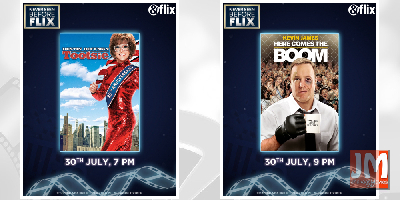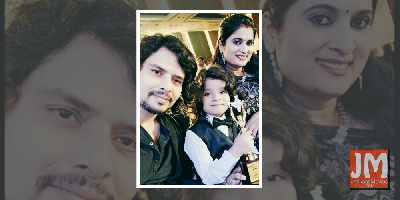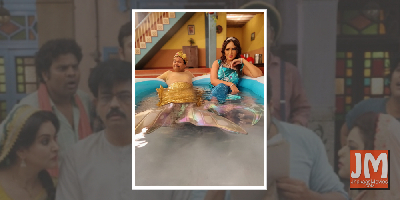 Aan Tiwari honoured with Best Child Actor award for Baal Shiv
Aan Tiwari honoured with Best Child Actor award for Baal Shiv Ghategi rahasymayi ghatnaye!
Ghategi rahasymayi ghatnaye! Amazon Prime Video unveils the 2021 Festive Line-up; brings a heady mix of Indian and International titles on the service
Amazon Prime Video unveils the 2021 Festive Line-up; brings a heady mix of Indian and International titles on the service Release: Music video of, Yeh Haalaath, from Mumbai Diaries 26-11
Release: Music video of, Yeh Haalaath, from Mumbai Diaries 26-11 Bhumi Pednekar feels she shares feel-good value with Akshay Kumar on screen
Bhumi Pednekar feels she shares feel-good value with Akshay Kumar on screen
Movie channels face redundancy (Column: B-Town)

BY VINOD MIRANI
The advent of OTT platforms seems to have put paid to the era of television movie channels. The kind of movies telecast on these channels makes it obvious that neither do they have the supply of new titles nor the wherewithal of any kind to compete against the OTT streaming. Actually, they cant even compete.
The television channels decide what you should watch, as against OTT platforms offering you a choice. You can choose a film or streaming programme to your liking. It is more obvious now that these TV channels are redundant. They keep repeating old films day after day.
One channel has mainly James Bond films to offer while another has the Spider-Man series, and rest just peddle third-rate action fantasies and superhero films! If you think that the channels are making film-watching more exciting for you by offering One Break or No Break movies, it is not because you don't like breaks; it is because advertisers would avoid wasting money on using these channels to advertise.
While all sorts of television channels are mushrooming in India, some region specific and some trying to cater universally to an all-India viewership, many of the regional ones are mostly news channels propped by political parties. Otherwise, in India, even for news, the viewers prefer their local language channels. The same is the case with serials and other such programmes. The preference is mostly region-wise.
In South India when it comes to all-round television, the preference is local channels. Others may have some viewership in the Southern metro cities and not in the hinterlands.
As for the news channels, quite honestly, they hardly qualify as news channels. All they deal in is politics, acting as mouthpiece of one or the other political party, and hence lack credibility. If you want to watch news as in what is happening around you, your city or state, you have to tune in to a local language channels. And, one phrase that the news channels have been misusing all day long is Breaking News, by breaking the same news all day long. How many times can a channel break the same news, till it is shattered into pieces?
Also, because these news channels have a definite bent towards one of the other party, their debate quorums lack all-round representation. In this event, the channels have on their debates what they call Political Analysts! As a rule, the stand they take is anti-establishment. What is a political analyst, which university prepares them for the job? This is a con played on the viewers.
These analysts are propped up by the channels on their own, taking a cue from the reality shows! Not surprising, these debates, the only drawing power of the news channels, don't count for much anymore, distancing the captive TV audience away from the box.
So much for the news channels. Like their credibility, their TRP wars are also questionable and that aspect is already under scrutiny by the law agencies.
In the days before the electronic media, a newspaper would spring up from every nook and cranny of the country. They were propped by the local politicians and, thanks to them, got government advertisements besides periodic handouts from the patron politician. With a circulation of 500 to 2,000 copies, they served as handbills singing paeans of the patron and were meant to be circulated mainly within his constituency.
This trend seems to have changed form, and is now being moved to the electronic media. The social media can be used by any and every political outfit but a visual medium is more effective. Hence, numerous television channels, backed by politicians, have taken to doing what the small-time newspapers did, which is to serve a party.
However, since the digital media is catching up thanks to spread of internet, the vlog (video blog) is the new medium of communication, also described as web television. While, food, transport, travel, locations and politics are the favoured themes, politics dominates. With a free platform on YouTube, there is a huge amount of output of vlogs now.
While on vlogs, they are popular in neighbouring Pakistan, too. And, guess what, the popular topic is India -- to compare Pakistan with India, nothing else as such. But, while comparing, these vlogs end up showing Pakistan in a poor light and add to the discomfiture of the Pakistan viewers. Where is the comparison? But that is probably what sells there!
Coming back to the more relevant, more sought-after entertainment channels. These are facing challenges, too.
Talking of primetime entertainment television channels, most of them survive mainly because of one or two serial at best. Usually a soap designed on the old-fashioned saas-bahu and joint family themes, where one woman calls the shots and girls who roam around in hot pants in real life, play the suffering victim. They cater to a section of female viewers.
When the serial era started on Doordarshan, it came up with a variety of themes which enjoyed a captive viewership. There were the family dramas, Hum Log and Buniyaad, the mythologies like Mahabharat and Ramayan, the film-based slots like Sunday feature, Phool Khile Hain Gulshan Gulshan, songs based programme, Chitrahaar and so on, and the women-centric serials, Udaan and Rajani. However, the universally popular serials were the comedies like Shrimaan Shrimati, Tu Tu Main Main, Karamchand, Dekh Bhai Dekh, Wagle Ki Duniya, Malgudi Days, Yeh Jo Hai Zindagi and Nukkad. Very few serials aired presently enjoy the popularity the DD serials did.
The private television channels started with Zee, which initially followed the same pattern as Doordarshan. Just as Doordarshan's most popular programmes were all film based, Zee too counted on these. Zee had gone on a buying spree of film rights soon after its inception at bargain prices, since filmmakers had no clue about the potential of the TV rights of their films. What mattered was they were getting more than what DD paid and that too across the table.
This initial capturing of the rights still makes Zee one of the best repertoires of films and sustains it in comparison to other movie channels. Shemaroo has a huge collection of classics and is opening up its channel gradually in many regions. Many new, privately-owned television channels opened up dedicated to films and general interest entertainment. Sony, Star, Rishtey Cineplex, B4U, Bflix, & Pictures -- with the same company owning multiple channels. There was stiff competition and the movie television rights prices skyrocketed. Knowing it was the star value of a film that dictated the price, film stars also jacked up their price. Somewhere, the equations went awry and became unviable. As a compromise, the stars started settling for the satellite rights in lieu of cash.
While the digital media backed OTT platforms, making it possible to view films and other content on a smartphone besides your TV set, the movie channels are losing viewership. The days to come don't look promising for these film-based television channels.
(Vinod Mirani is a veteran film writer and box office analyst. The views expressed are personal)
Tags: Cinema, Showbiz, Lifestyle, Fashion, Quote Unquote








